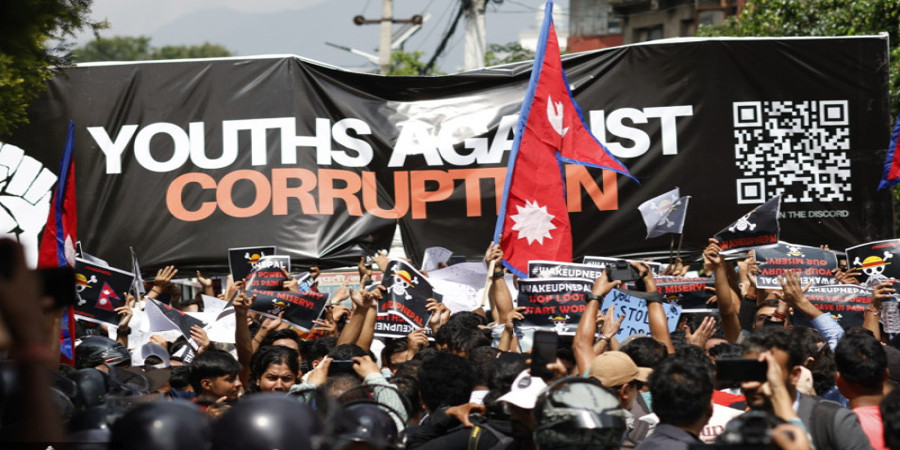
ছবি: -Collected Photo
Kathmandu was rocked by waves of protest on Monday as thousands of students, youth, and ordinary citizens clashed with security forces in what has quickly escalated into one of Nepal’s most significant uprisings in recent years. The immediate trigger was the government’s recent decision to impose sweeping restrictions on social media platforms, a move that protesters see as a direct assault on freedom of expression.
The morning began with unusual tension across the capital. In New Baneshwar, small groups of university students gathered with placards reading, “End Corruption,” “Restore Freedom of Speech,” and “No to Social Media Ban.” What started as a peaceful march soon spiraled into violence by midday. According to eyewitness accounts, a group of demonstrators attempted to storm the main gates of the Federal Parliament building. Security forces initially tried to block them with barricades, but when those fell, the crackdown intensified—tear gas, water cannons, and rubber bullets filled the streets. Soon, the sharp crack of live gunfire echoed through the area.
The controversy began weeks earlier when authorities argued that unregulated social media was spreading “fake news” and “anti-state propaganda.” Last Thursday, the government announced it would block major platforms, including Facebook, X (formerly Twitter), and YouTube, unless they complied with a new state-run registration system. Officials insisted the measures were needed to safeguard national security and prevent disinformation, but for Nepal’s digital generation, the move was seen as censorship.
For Generation Z, raised in Nepal’s digital era, platforms like Facebook, TikTok, and Instagram are not merely sources of entertainment—they are spaces for political dialogue, community building, and mobilizing protests. Many young people interpreted the ban as an attempt to silence their voices. Their outrage quickly spilled onto the streets.
Initially, demonstrators had planned only a sit-in outside the parliament building. But as word spread, the crowd swelled with unemployed youth, small traders, and even civil servants frustrated by years of political dysfunction. They carried not only slogans against the social media ban but also long-standing grievances about corruption, nepotism, and economic stagnation. “Our leaders have stolen opportunities from us,” said one protester, a recent graduate struggling to find work. “We have no jobs, no accountability in government, and now they want to take away our right to speak.”
As the day wore on, chaos deepened. By evening, at least 14 people had been killed, according to hospital sources, with several hundred injured, including journalists, camera operators, and security personnel. Many suffered head, chest, and eye injuries from rubber bullets and tear gas canisters. Videos circulating online showed demonstrators scrambling through clouds of tear gas and police charging with batons.
The government placed the blame squarely on the protesters, accusing them of attacking police and damaging state property. Protest leaders, however, countered that the violence began only after security forces used excessive force against a peaceful march. “We were marching with slogans, nothing more. Then the tear gas came, unprovoked. That’s when panic and anger took over,” said a student protester.
In response to the unrest, the Kathmandu district administration imposed indefinite curfews in several areas, deploying police, army units, and paramilitary forces. Despite the restrictions, students and young people continued to defy orders, pouring back into the streets after nightfall in scenes reminiscent of Nepal’s past uprisings.
The political fallout has been swift. Opposition parties have demanded the resignation of the prime minister and the home minister, holding them directly responsible for the deaths. Civil society groups and rights organizations have also condemned the government’s crackdown, calling it a betrayal of democratic principles won after years of struggle. Analysts argue that what began as a dispute over social media has now morphed into a larger movement against systemic failures.
“This is not just about Facebook or TikTok,” said one political commentator in Kathmandu. “It is about young people demanding a government that works for them, not against them. Years of corruption, unemployment, and broken promises have left a generation without hope. The social media ban was merely the spark that set everything ablaze.”
Observers warn that the protests represent a turning point in Nepal’s political trajectory. The country has faced instability for decades, from monarchy to republic, civil war to fragile democracy. But the sheer scale and energy of this youth-led movement stand out as unprecedented in recent memory. “If the government ignores this outcry, the crisis could deepen into something far harder to contain,” another analyst noted.
For now, Kathmandu remains under heavy security, its streets scarred by clashes. But despite curfews and bans, protesters continue to chant for accountability, transparency, and the restoration of their digital freedoms. As one young demonstrator shouted before being led away by police, “You can ban our apps, but you cannot silence our generation.”
repoter






